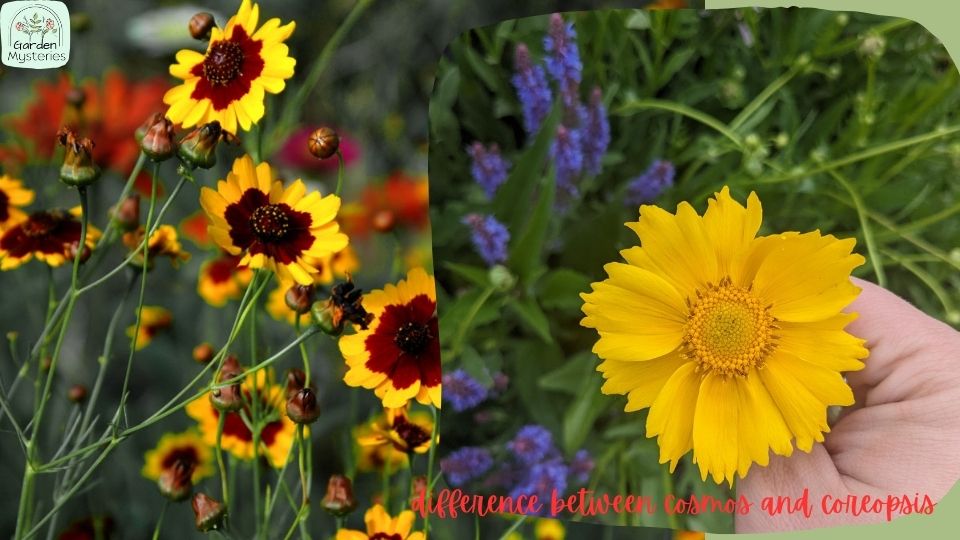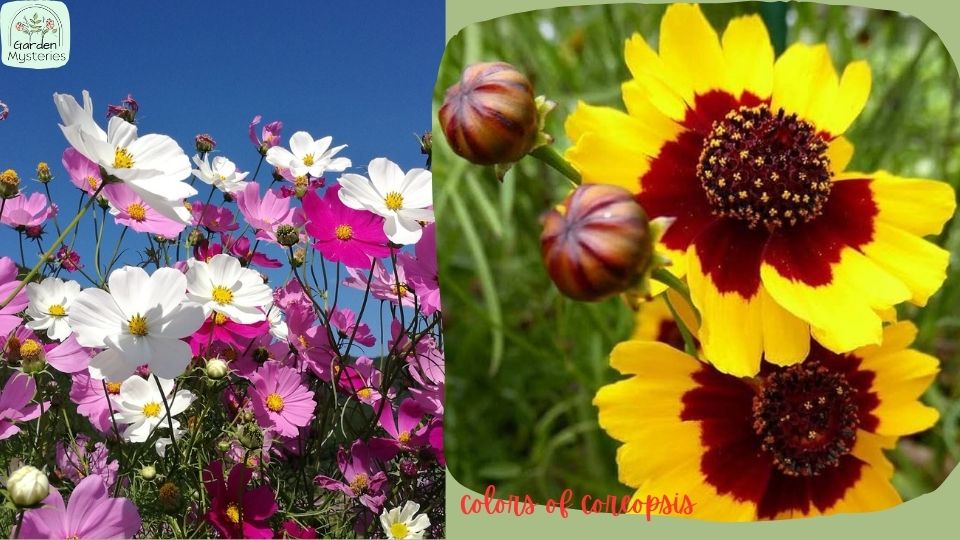Coreopsis vs Cosmos: Which One’s Better for Your Garden?
Beginners often get confused between Coreopsis and Cosmos. Coreopsis vs Cosmos, these two flowers may seem similar at first glance, but they have distinct features that set them apart.
Coreopsis, often called “Tickseed,” is a perennial known for its daisy-like flowers and feathery foliage. Cosmos, on the other hand, are annual flowers that offer a wide array of colorful blooms and fern-like leaves.
So, today I’ll walk you through the similarities and differences in detail. You should keep reading till the end.
What is Coreopsis?
Coreopsis, commonly known as “Tickseed,” is a charming coreopsis flowers perennial cherished in gardens for its vivid daisy-like blooms. With a range of hues including yellow, pink, and red, Coreopsis adds a burst of color to landscapes.
Its feathery foliage complements the flowers and gives the plant an airy appearance. Thriving in full sun and well-draining soil, Coreopsis is versatile and suitable for borders, containers, or ground cover.
A pollinator favorite, it attracts butterflies and bees with its nectar-rich blossoms. Its drought resistance and resistance to deer make it a low-maintenance choice. Coreopsis is known for its longevity, returning to grace gardens year after year.
Whether in cottage-style or formal gardens, coreopsis flowers perennial bring a cheerful and enduring charm.
What is Cosmos?
Cosmos, an annual flowering plant, boasts delicate fern-like leaves and a profusion of captivating blossoms in shades spanning pink, white, orange, and more. Flourishing in full sun and various soil types, Cosmos offers a casual and naturalistic allure to gardens.
With easy-to-sow seeds, they’re a favorite among beginners. Regular deadheading prolongs their flowering. Also, it encourages their self-sowing behavior, leading to new blooms in subsequent years.
Pollinators like bees and butterflies are drawn to Cosmos, making it a beneficial addition to pollinator-friendly landscapes.
While not as long-lived as perennials, Cosmos compensates with its ability to readily self-sow, ensuring a continuous cycle of vivid blooms. Whether in cottage gardens, wildflower meadows, or informal settings, Cosmos imparts a touch of wild beauty to outdoor spaces.
Similarities Between Coreopsis and Cosmos
The similarities between Coreopsis and Cosmos go beyond their attractive blooms. Coreopsis vs cosmos is not so common in the gardeners’ talk.
From their pollinator-friendly nature to their adaptability and relatively easy maintenance, these flowers offer gardeners a chance to cultivate a lively and welcoming outdoor space.
Also, it supports local wildlife and brings joy through bursts of vivid color. And the difference between cosmos and coreopsis is quite low.
Colorful Blooms
Both Coreopsis and Cosmos are renowned for their colorful blooms that add vibrancy to gardens. Coreopsis flowers come in shades of yellow, pink, red, and even bicolor variations.
On the other hand, Cosmos showcases an array of colors including pink, white, orange, and chocolate.
Pollinator Magnet
Both flowers are highly attractive to pollinators like bees and butterflies. Their open, nectar-rich blooms provide easy access for these beneficial insects.
Thus it makes them valuable additions to pollinator-friendly landscapes that support biodiversity.
Sun-Loving Plants
Coreopsis and Cosmos share a preference for full sun. They thrive when exposed to ample sunlight. Also, it ensures healthy growth and prolific flowering throughout the growing season.
Low Maintenance
Both plants are relatively low-maintenance choices for gardens. Once established, they require minimal care. So, they are suitable for busy gardeners or those new to gardening.
Deadheading for Extended Blooming
A common practice for both Coreopsis and Cosmos is deadheading, removing spent flowers.
This not only encourages more blooms to emerge but also helps redirect the plant’s energy towards flower production. Also, it results in a longer-lasting display of beauty.
Versatility in Landscaping
Coreopsis and Cosmos can both be used in various landscaping settings. Coreopsis’ neat growth habit makes it ideal for borders, container gardening, and even as a ground cover.
Cosmos’ wilder growth adds a touch of informality. So, it can be a great fit for cottage-style gardens, wildflower meadows, and more naturalistic landscapes.
Self-Sowing Potential
While Coreopsis is a perennial that returns each year, Cosmos compensates for its annual lifespan with its self-sowing ability.
Both plants have the potential to provide ongoing beauty in your garden. Coreopsis through its perennial nature and Cosmos by reseeding itself.
Drought Tolerance
Both Coreopsis and Cosmos exhibit a certain level of drought tolerance. It’s important to provide adequate water during their establishment period. Once they are well-rooted, they can handle drier conditions without much fuss.
Coreopsis VS Cosmos: At a Glance
Here’s a quick Coreopsis vs Cosmos comparison table:
| Aspect | Coreopsis | Cosmos |
| Type | Perennial | Annual |
| Bloom Colors | Yellow, Pink, Red, Bicolor | Pink, White, Orange, etc. |
| Growth Habit | Clumps with tall stems | Upright, open and airy |
| Foliage | Fern-like | Feathery, finely divided |
| Longevity | Multi-year (perennial) | Single year (annual) |
| Propagation | Division, Plants | Seeds, Self-sowing |
| Formality | Formal, structured | Informal, naturalistic |
| Pollinators | Attracts pollinators | Attracts pollinators |
| Self-Sowing | Limited | Prolific |
| Suitable For | Borders, Containers | Cottage gardens, Meadows |
| Lifespan | Long-term presence | One-season blooms |
| Deadheading | Encourages more blooms | Encourages reseeding |
| Sunlight Preference | Full sun | Full sun |
| Deer Resistance | Generally resistant | Varies |
Before we jump into the details, you can visit another topic on whether the cosmos can grow in shade or not.
Differences between Coreopsis and Cosmos
The difference between cosmos and coreopsis encompass their growth habits, lifespans, appearances, and much more. So, let’s go through the elaborate difference between Coreopsis and Cosmos:
Growth Habit
Coreopsis: Coreopsis is a perennial plant, meaning it comes back year after year. It forms clumps of foliage and produces blooms on tall stems. Coreopsis seeds are not required.
Cosmos: Cosmos is an annual plant, completing its lifecycle within a single growing season. It grows from seed, blooms, produces Cosmos seeds, and then dies off. So, it is necessary to replant each year.
Blooms and Foliage
Coreopsis: Coreopsis flowers are typically daisy-like with distinct petal shapes. They have a more compact and organized appearance. The foliage is often fern-like, contributing to the plant’s airy texture.
Cosmos: Cosmos flowers are also daisy-like but tend to have a more open and delicate appearance. The foliage is feathery and finely divided, giving the plant a light and airy feel.
Longevity
Coreopsis: Because of coreopsis flowers perennial nature, Coreopsis can live for multiple years, returning each spring with new growth and blooms.
Cosmos: Being an annual, Cosmos completes its lifecycle in one season and does not come back the following year. However, it often self-seeds, leading to new plants in subsequent years if allowed to drop seeds.
Color Range
Coreopsis: Colors of coreopsis come in a variety including shades of yellow, pink, red, and bicolor combinations.
Cosmos: Cosmos offers a broad color palette including shades of pink, white, orange, and even dark maroon.
Planting and Regeneration
Coreopsis: Propagation of Coreopsis is usually done through division or planting nursery-grown plants. It doesn’t regenerate itself from seeds as vigorously as Cosmos.
Cosmos: Cosmos readily reseeds itself, dropping seeds that germinate in the following growing season. This natural self-sowing behavior can lead to new plants emerging in unexpected areas.
Formal vs. Informal Appearance
Coreopsis: Coreopsis generally has a more formal and organized appearance because of its compact growth habit, making it suitable for borders and structured garden designs.
Cosmos: Cosmos has a more casual and naturalistic look, often used in cottage gardens or wildflower meadows to create a more relaxed and informal atmosphere.
Self-Sowing Behavior
Coreopsis: While Coreopsis can self-sow to some extent, it’s not as prolific as Cosmos in terms of generating new plants from dropped seeds.
Cosmos: Cosmos is known for its abundant self-sowing. If allowed to go to seed, it can create a natural, evolving display in subsequent years.
Lifespan and Replacement
Coreopsis: Coreopsis provides a consistent presence in the garden over the years, saving gardeners from having to replant each season.
Cosmos: Because of its annual nature, Cosmos requires replanting every year to maintain its presence in the garden.
Which One is Easier to Grow: Coreopsis or Cosmos?
If you’re new to gardening, both Coreopsis and Cosmos are beginner-friendly, but they offer different experiences.
Coreopsis is a low-maintenance perennial that comes back each year. It thrives in full sun and well-drained soil, needing minimal care once established. You won’t have to replant it annually, making it a reliable choice for long-term garden planning. It’s ideal if you want something that stays put and continues to bloom with little effort.
Cosmos, on the other hand, is a fast-growing annual that blooms quickly from seed. It’s perfect for those who enjoy easy, colorful results within one season. Cosmos can also self-sow, so you might see new blooms next year without replanting.
If you prefer a “plant it once” approach, go with Coreopsis. If you enjoy starting from seed and love seeing quick results, Cosmos may be your best bet. Both plants are perfect for sunny spaces and pollinator-friendly gardens.
FAQs
Can I grow Coreopsis and Cosmos together in the same garden?
Combining Coreopsis and Cosmos can create a dynamic garden with the best of both worlds. Coreopsis’ perennial presence pairs well with Cosmos’ annual bursts of color. Also, it allows for a changing yet consistent landscape.
Which flower is more suitable for a structured garden design between Coreopsis and Cosmos?
Coreopsis is ideal for a structured design because of its compact growth and organized appearance.
Its clumping habit makes it perfect for borders and container gardening. In contrast, Cosmos’ informal and airy growth suits more naturalistic landscapes like cottage gardens and wildflower meadows.
Can I expect Coreopsis and Cosmos flowers to self-sow in my garden?
Yes, but to varying degrees. Coreopsis can self-sow, but not as vigorously as Cosmos. Cosmos is known for its prolific self-sowing behavior, often leading to new plants in subsequent years without additional planting.
Finally, you can read a comparison between Black Kow and Miracle Grow before you say goodbye. Thank you for supporting us and appreciating the colors of coreopsis.









